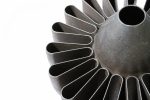
3DPRINTINGINDUSTRY.COM
Meltio unveils its new Meltio Blue Engine for metal AM at Formnext 2024
Metal 3D printer manufacturer Meltio has introduced the Meltio Engine Blue integration kit at Formnext 2024.Designed to integrate seamlessly with industrial robotic arms and vertical machining centers, this new system aims to enhance the process of metal 3D printing parts. Leveraging factory-calibrated Blue Laser technology, it offers substantial improvements in productivity, energy efficiency, and ease of use, building on the foundations of the Meltio Engine V3.In Hall 12.0 Booth C119, the manufacturer is demonstrating Meltio Engine Blues versatility with metal parts made from marine bronze, copper, dual-wire materials, and a build plate integrating tool steel, mild steel, marine bronze, and stainless steel, highlighting its capability for multi-material and complex material production.The new Meltio Engine Blue represents a crucial breakthrough in Meltios directed energy deposition (DED) technology, designed specifically to respond to the current demands of the manufacturing industry around the world. For our industrial customers, the Meltio Engine Blue represents a significant improvement in reliability and deposition rate, enabling increased production speed and quality, explains Meltio Product Manager, Alejandro Nieto.Jet engine exhaust created using Meltio Blue Engine. Image via Meltio.Faster metal parts production and streamlined operationsBoasting a deposition rate that is up to 3.5 times higher than its predecessor and a 30% reduction in energy consumption, this system highlights its efficiency in metal AM processes. Simplified installation and maintenance are achieved through a compact, lightweight design that eliminates components like fiber optics and collimators.These updates enhance operational reliability, allowing the creation of high-density, durable metal parts for industries like aerospace, automotive, defense, energy, maritime, mining, and oil and gas, with various materials that can be processed with precision.Nieto emphasized that the development of the Meltio Engine Blue involved over two years of meticulous work. The engineering team collaborated closely with partners and integrators to address challenges identified with the previous V3 system. Key industry demands, such as reducing maintenance time, enhancing reliability, and improving deposition rates, guided the development process.Several technical upgrades play a vital role in the advanced capabilities of Meltio Engine Blue. A dual wire-feeding system, featuring internal motors and a 10-meter wire roller liner, ensures stable material handling for uninterrupted operation. High-quality servo motors on the T0, T1, and Z axes, along with encoders on feeders and an absolute encoder on the Z axis, contribute to precise and stable deposition.Process oversight is further enhanced by an integrated melt pool camera, which allows real-time monitoring of operations. Customers will also benefit from features such as quick-connect components for easier installation, screen options in 27 and 17 sizes, and an optional deployable deposition head for expanded applications.In addition, safety measures have been upgraded to meet the highest industrial standards. A service mode key, coupled with redundant internal safety systems, ensures secure operations in demanding environments.By reducing maintenance needs and eliminating frequent laser alignment, the system minimizes downtime while improving operational efficiency. A 30% reduction in energy consumption compared to the previous version helps lower operating costs and contributes to sustainability goals.As per Meltio, higher deposition rates and reduced maintenance requirements make the system a practical choice for manufacturers aiming to optimize production workflows without compromising quality.A nozzle guide vane. Image via Meltio.Technical specifications of the Meltio Engine BlueLaser SystemBlue Laser (Higher absorption and power efficiency; wider range of compatible materials than IR) 1000W 9 x 450 nm direct diode lasersPrintheadRobot Mounted 20.5 to 23 kgPrinthead Size (W x D x H)262 x 272 x 572 mmControl UnitWall mounted, air-cooled 80.5 kg 600 x 300 x 800 mm. Separate wall mounted 27 HMICoolingWater-cooled deposition head, chiller includedPrint Envelope (W x D x H)Depending on robots reachProcess ControlMelt Pool Camera & Closed-loop wire modulationPower Input200/240 V 3W+PE 380/415 V 3W+N+PEPower Consumption9,2 kW peak 2-5 kw avgSlicer SoftwareMeltio Space 1-year subscription includedFeeder SystemQuad-point traction servomotor feeder, frictionless linersWire FeedstockDiameter: 0.8-1.2 mm / Spool Type: 8S300 External wire drum readyProduct ConfigurationsSingle or dual wireCompatible MaterialsStainless steels, carbon steels, tool steels, nickel alloys, titanium, copper alloys, gold alloys and moreCatch up on all the news fromFormnext 2024.Voting is now open for the2024 3D Printing Industry Awards.Want to share insights on key industry trends and the future of 3D printing? Register now to be included in the2025 3D Printing Industry Executive Survey.What 3D printing trends do the industry leaders anticipate this year?What does the Future of 3D printing hold for the next 10 years?To stay up to date with the latest 3D printing news, dont forget to subscribe to the 3D Printing Industry newsletter or follow us on Twitter, or like our page on Facebook.While youre here, why not subscribe to our Youtube channel? Featuring discussion, debriefs, video shorts, and webinar replays.Featured image shows a jet engine exhaust created using Meltio Blue Engine. Image via Meltio.Ada ShaikhnagWith a background in journalism, Ada has a keen interest in frontier technology and its application in the wider world. Ada reports on aspects of 3D printing ranging from aerospace and automotive to medical and dental.
0 Commenti
0 condivisioni
29 Views


